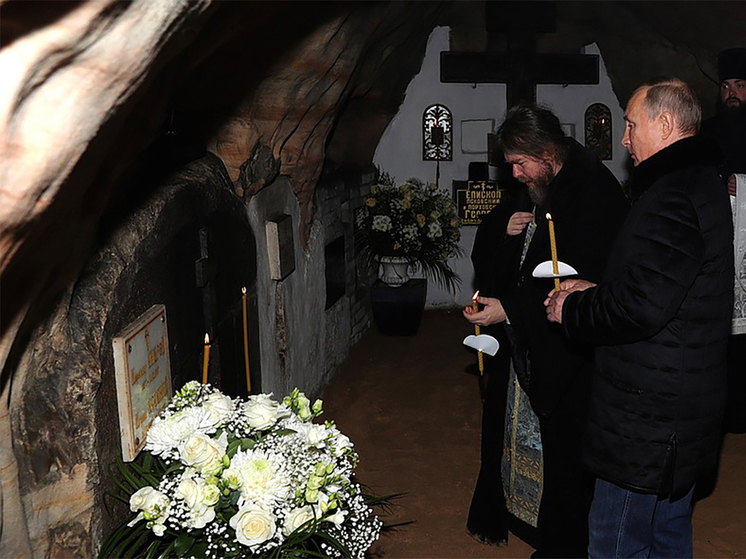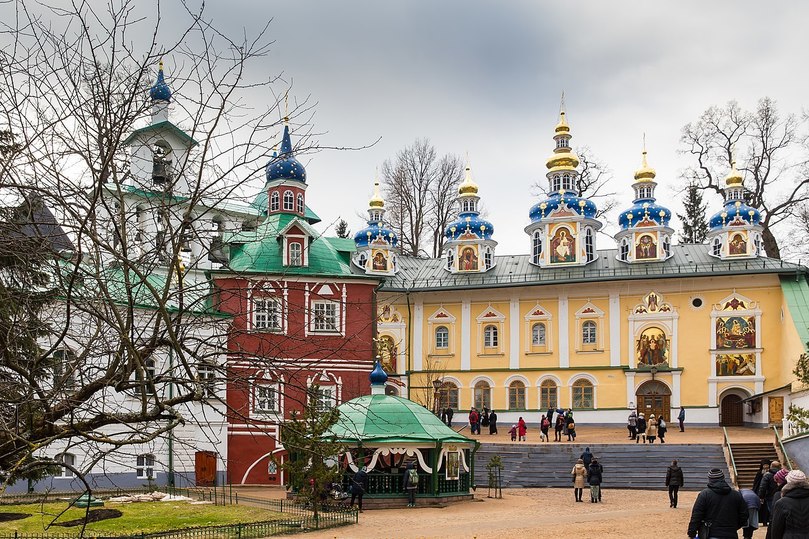Cosmic rays helped them in this
Russian scientists discovered many previously unknown underground streets, huge crypts and other spaces with vaults in the ancient «God-built» Caves of the Assumption Pskov-Pechersky Monastery. This sensational discovery became possible thanks to the muonography method — registration of cosmic particle fluxes, which are then used to create 3D models of underground objects.
The scientific supervisor of the project is the chief researcher of the Physical Institute. Lebedeva RAS Natalya Polukhina told MK about the progress of the study and interesting findings.
 Vladimir Putin with Metropolitan Tikhon in the Pskov Caves Monastery
Vladimir Putin with Metropolitan Tikhon in the Pskov Caves Monastery
Dormition Pskov-Caves Monastery — one of the largest and most famous monasteries in Russia with a long history, located in the city of Pechory (its name comes from the old Russian word «pechery» — caves). It was founded 550 years ago (in 1473), – The cave church of the Dormition of the Mother of God, excavated by the Monk Jonah in a sandstone hill, was the first to be consecrated here. The monastery is famous for the fact that it has never been closed in its entire history.
It is believed that these caves were created by God himself, – hence their name «God built.» In different centuries, including modern times, up to 14 thousand people were buried in them. The main mystery of the local crypts – the absence of decay is simply called a miracle.
According to legend, the caves of the monastery are laid to the city of Izborsk, which is about 20 kilometers from Pechory. In the year of the 550th anniversary of the monastery, it was decided to search for new spaces with the help of… cosmic particles – muons. They allow you to look into the most hidden corners of the shrine without destroying it.

— Muons — these are particles that, to be more precise, are considered secondary cosmic particles, which are formed under the influence of primary cosmic particles already in our earthly atmosphere, – explains Natalya Polukhina, who is also a professor at MEPhI and a leading expert at MISIS. – Muons, whose density reaches 10 thousand pieces per square meter, can fly long distances. The largest depth they have reached – two kilometers of rock.
– No. But if some large target is encountered on their way: a volcano, a house, or a mountain with caves, as in our case, then muons, traveling along them, can create their own tracks — lines, by changes in which we can draw conclusions about the internal structure of objects. Where the density of the structure is higher, — there will be few muons, where below or there is a cavity, – there will be a large flux of muons. And there is no need to drill wells in order to find out the structure of the object.
– Our goal was to explore two places in the caves. This is a crypt, hidden behind a huge, human-sized icon that greets those entering even at the level of the first floor of the Assumption Cathedral, and one of the underground corridors considered to be a dead end.
So, about the crypt. The story said that it contained the burial of ancient noble people, but it was walled up, covered with an icon, and no one knows what its true size is. We examined it and found out that its size is quite impressive: 2.5 by 2.5 meters and from it leads an additional passage to other rooms of the caves.
The second task for us was to explore the short Troitskaya street of the underground «city». In the explored area, it does not even reach the wall of the monastery. We were asked to see if she had a sequel, and we showed that she not only has a sequel, – it also hides and a previously unknown cavity! We discovered it unexpectedly: the room is located to the right of Troitskaya Street (if you are facing a dead end). Its huge size is amazing: 3 by 6 meters in the horizontal plane and 3 meters in height!
 Photo of the 3D model of the God-created Uspensky caves Pskov-Caves Monastery. Photo courtesy of N. Polukhina
Photo of the 3D model of the God-created Uspensky caves Pskov-Caves Monastery. Photo courtesy of N. Polukhina
— 12 meters long and 2 meters wide.
– We have placed 13 detectors in the caves. Two of them measured the general background, the rest were dispersed around two areas of observation. We determined the sizes of objects by the intersection of 4 detectors for each area.
– The method of using cosmic radiation for «transillumination» large objects by analogy with X-ray was proposed back in 1926 by the Russian academician Lazarev. But muons — the only particles that are suitable for such work are – were not yet open at that time. Therefore, the first muonography appeared only in 1955, when in Australia it was used to measure the depth of the tunnel. Even more famous is the Nobel laureate Luis Alvarez, who, with the help of muons, explored the pyramid of Khafre (the second largest Egyptian pyramid — Auth.) in 1965. But he used the so-called spark chamber, which allowed him to examine only 10% of the volume of the pyramid, and despite this, Alvarez concluded that it had no voids…
The method that we use today is &ndash ; this is the most modern method using nuclear emulsion plate detectors. In fact, plates – this is a photographic film, only very, very sensitive: at a distance of 1 kilometer, the emulsion «can see» object 15 meters long. Film processing is carried out using powerful microscopes with precise mechanics, high-speed cameras. Since 2003, Japanese colleagues have been using similar equipment to explore volcanoes, blast furnaces, and nuclear power plants. In the USA similar researches are also put on stream.
– This is so, despite the fact that the coffins are not buried there, but simply placed in wall holes.
– We have explored only two sites, but I am sure that in other parts of the caves of the monastery there may be new unexplored cavities hiding ancient history.


